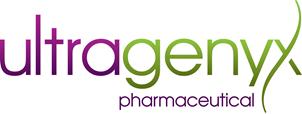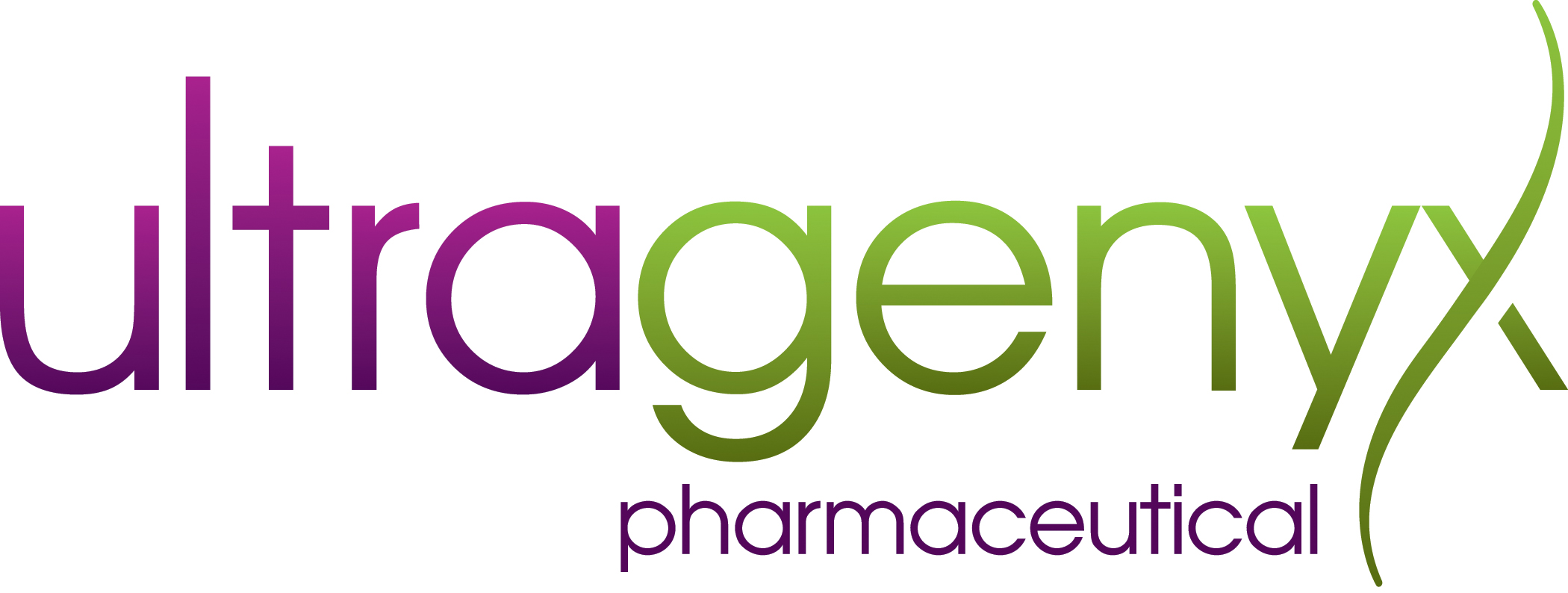Exhibit 99.1

Contact Ultragenyx Pharmaceutical Inc.
844-758-7273
For Media, Bee Nguyen
For Investors, Robert Anstey
Ultragenyx Reports First Quarter 2014 Financial Results and Corporate Update
NOVATO, CA – May 12, 2014 – Ultragenyx Pharmaceutical Inc. (NASDAQ: RARE), a biopharmaceutical company focused on the development of novel products for rare and ultra-rare diseases, today reported its financial results and corporate update for the first quarter ended March 31, 2014.
“We have continued to make progress with our pipeline of clinical-stage programs for five diseases since the completion of our initial public offering in early 2014,” said Emil D. Kakkis, Ph.D., M.D., Chief Executive Officer and President of Ultragenyx. “We are encouraged by the clinical results from our recombinant human beta-glucuronidase (rhGUS), sialic acid extended-release (SA-ER), and KRN23 programs, as well as the initiation of clinical studies for our triheptanoin programs.”
First Quarter 2014 Financial Results
For the first quarter of 2014, Ultragenyx reported a net loss attributable to common stockholders of $18.4 million, or $0.85 per share, basic and diluted, compared with a net loss attributable to common stockholders for the first quarter of 2013 of $8.2 million, or $2.84 per share, basic and diluted. Net loss attributable to common stockholders differs from net loss due to dividends and other charges related to outstanding preferred stock, which was converted into common stock upon the company’s initial public offering.
Total operating expenses for the first quarter of 2014 were $10.3 million compared with $6.7 million for the same period in 2013. The increase in total operating expenses is due to the expansion and advancement of Ultragenyx’s clinical development pipeline, including the initiation of clinical studies for triheptanoin and recombinant human beta-glucuronidase (rhGUS), as well as increased headcount.
Cash, cash equivalents, and short-term investments were $165.4 million as of March 31, 2014. Based on current operating levels, the company expects that this will be sufficient to fund operations into 2016.
Corporate Update
KRN23 anti-FGF23 Monoclonal Antibody in X-linked Hypophosphatemia (XLH)
· | Data from the Phase 1/2 adult repeat-dose studies completed by Ultragenyx’s collaborative partner Kyowa Hakko Kirin Co., Ltd. (KHK) are expected to be released at scientific conferences in 2014. |
· | Ultragenyx expects to initiate a Phase 2 study in pediatric XLH patients in the second half of 2014, following discussions with multiple regulatory agencies regarding study design. |
rhGUS in Mucopolysaccharidosis 7 (MPS 7)
· | Preliminary data from the Phase 1/2 study were presented at the American College of Medical Genetics and Genomics (ACMG) Annual Clinical Genetics Meeting in March 2014. |
· | Results from three patients who had been administered 2 mg/kg of rhGUS every other week for two, six, and 12 weeks showed evidence of clearance of lysosomal storage, as indicated by the decrease in urinary GAG excretion beginning at two weeks of treatment of approximately 30-50%. |

· | At the 12-week assessment of the first patient, absolute liver size was reduced by approximately 11%. This represented a 46% decrease in the excess liver size above normal for age and gender. The remaining patients had not yet reached the 12-week time point for liver size assessment. |
· | No serious adverse events were observed during up to 12 weeks of treatment, and no infusion-associated reactions were observed after a total of 13 infusions to date in these three subjects. |
· | The Phase 1/2 study will continue, and additional 12-week interim data are expected in the second half of 2014. If these results are supportive, Ultragenyx plans to initiate a pivotal Phase 3 study. |
Triheptanoin in Long-Chain Fatty Acid Oxidation Disorders (LC-FAOD)
· | Ultragenyx continues to enroll and treat patients in the ongoing Phase 2 study of triheptanoin in approximately 30 severely affected LC-FAOD patients. The company expects that data from this study should be available in 2015. |
Triheptanoin in Glucose Transporter Type-1 Deficiency Syndrome (Glut1 DS)
· | Ultragenyx continues to enroll and treat patients in the ongoing Phase 2 study of triheptanoin in up to 50 Glut1 DS patients. The company expects to release data from this study in 2015. |
· | The company continues to support multiple investigator-sponsored clinical studies testing triheptanoin in a variety of potential indications. |
Sialic Acid Extended-Release (SA-ER) in Hereditary Inclusion Body Myopathy (HIBM)
· | Data from the randomized, double-blind, placebo-controlled Phase 2 study of SA-ER in 47 HIBM patients were presented at the American Academy of Neurology (AAN) Annual Meeting in April 2014. |
· | Patients in the study were initially randomized to receive placebo, 3 grams, or 6 grams of SA-ER per day. After 24 weeks, placebo patients crossed over to either 3 grams or 6 grams total daily dose, on a blinded basis, for an additional 24 weeks. The final analysis compared change at week 48 from baseline for the combined groups at 6 grams versus 3 grams of SA-ER. Assessments included pharmacokinetics, composites of upper extremity and lower extremity muscle strength as measured by dynamometry, other clinical endpoints, patient reported outcomes, and safety. |
· | At 24 weeks, assessments of upper extremity composite of muscle strength showed a statistically significant difference in the 6 gram group compared to placebo (+2.33 kg; 5.5% relative difference from baseline; p=0.040). At 48 weeks, a statistically significant difference between the combined 6 gram group and the combined 3 gram group was observed (+3.44 kg; 8.5% relative difference from baseline; p=0.0033). Patients with less advanced disease (able to walk more than 200 meters at baseline), a predefined subset, showed a more pronounced difference (+4.69 kg; 9.7% relative difference from baseline; p=0.00055). The lower extremity composite showed a similar pattern of response, but did not show a statistically significant difference between the dose groups. None of the groups showed a significant decline in the lower extremity composite during the treatment period. A positive trend was seen in patient-reported outcomes of functional activity. |
· | SA-ER appeared to be well tolerated with no serious adverse events observed to date in either dose group, and no dose-dependent treatment-emergent adverse events were identified. Most adverse events were mild to moderate and most commonly gastrointestinal. |
· | Ultragenyx continues to treat patients in an extension study evaluating an increased daily dosage of sialic acid based on the dose dependent response observed at weeks 24 and 48 of the Phase 2 study. |
About Ultragenyx
Ultragenyx is a development-stage biopharmaceutical company committed to bringing to market novel products for the treatment of rare and ultra-rare diseases, with an initial focus on serious, debilitating genetic diseases. Founded in 2010, the company has rapidly built a diverse portfolio of product candidates with the potential to address diseases for which the unmet medical need is high, the biology for treatment is clear, and for which there are no approved therapies.

The company is led by a management team experienced in the development and commercialization of rare disease therapeutics. Ultragenyx’s strategy is predicated upon time and cost-efficient drug development, with the goal of delivering safe and effective therapies to patients with the utmost urgency.
For more information on Ultragenyx, please visit the company’s website at www.ultragenyx.com.
Forward-Looking Statements
Except for the historical information contained herein, the matters set forth in this press release, including statements regarding Ultragenyx's expectations regarding sufficiency of existing cash, cash equivalents and short-term investments to fund operations for projected periods of time, timing of release of additional data for its product candidates, timing of initiation of additional studies for its product candidates, plans regarding ongoing studies for existing programs and potential benefits of its products under development are forward-looking statements within the meaning of the "safe harbor" provisions of the Private Securities Litigation Reform Act of 1995. Such forward-looking statements involve substantial risks and uncertainties that could cause our clinical development programs, future results, performance or achievements to differ significantly from those expressed or implied by the forward-looking statements. Such risks and uncertainties include, among others, the uncertainties inherent in the clinical drug development process, including the regulatory approval process, the timing of our regulatory filings and other matters that could affect the availability or commercial potential of our drug candidates. Ultragenyx undertakes no obligation to update or revise any forward-looking statements. For a further description of the risks and uncertainties that could cause actual results to differ from those expressed in these forward-looking statements, as well as risks relating to the business of the company in general, see Ultragenyx's Annual Report on Form 10-K for the fiscal year ended December 31, 2013, filed with the Securities and Exchange Commission on March 24, 2014, and its subsequent periodic reports filed with the Securities and Exchange Commission.

Ultragenyx Pharmaceutical Inc.
Selected Statements of Operations Financial Data
(in thousands, except share and per share amounts)
| Three Months Ended March 31, | | |
| 2014 | | | 2013 | | |
Statements of Operations Data: | | | | | | | | |
Operating expenses: | | | | | | | | |
Research and development | $ | 8,353 | | | $ | 5,664 | | |
General and administrative | | 1,986 | | | | 1,083 | | |
Total operating expenses | | 10,339 | | | | 6,747 | | |
Loss from operations | | (10,339 | ) | | | (6,747 | ) | |
Other expense, net | | (3,291 | ) | | | 12 | | |
Net loss | $ | (13,630 | ) | | $ | (6,735 | ) | |
Net loss attributable to common stockholders | $ | (18,438 | ) | | $ | (8,205 | ) | |
Net loss per share attributable to common stockholders, basic and diluted | $ | (0.85 | ) | | $ | (2.84 | ) | |
Shares used to compute net loss per share attributable to | | | | | | | | |
common stockholders, basic and diluted | | 21,582,435 | | | | 2,893,997 | | |
| | | | | | | | |

Ultragenyx Pharmaceutical Inc.
Selected Balance Sheets Financial Data
(in thousands)
| March 31, | | | December 31, | | |
| 2014 | | | 2013 | | |
Balance Sheet Data: | | | | | | | | |
Cash, cash equivalents and short-term investments | $ | 165,397 | | | $ | 53,377 | | |
Working capital | | 162,825 | | | | 49,304 | | |
Total assets | | 172,707 | | | | 59,649 | | |
Convertible preferred stock warrant liability | | — | | | | 3,419 | | |
Convertible preferred stock | | — | | | | 124,930 | | |
Deficit accumulated during the development stage | | (92,869 | ) | | | (74,836 | ) | |
Total stockholders' equity (deficit) | | 165,714 | | | | (74,821 | ) | |
| | | | | | | | |

